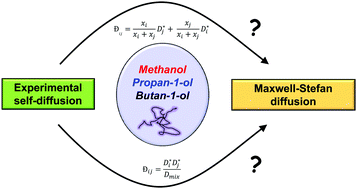当前位置:
X-MOL 学术
›
Phys. Chem. Chem. Phys.
›
论文详情
Our official English website, www.x-mol.net, welcomes your
feedback! (Note: you will need to create a separate account there.)
Maxwell–Stefan diffusion coefficient estimation for ternary systems: an ideal ternary alcohol system
Physical Chemistry Chemical Physics ( IF 2.9 ) Pub Date : 2017-06-05 00:00:00 , DOI: 10.1039/c7cp02582c Tariq Allie-Ebrahim 1, 2, 3, 4 , Qingyu Zhu 1, 2, 3, 4 , Pierre Bräuer 1, 2, 3, 4 , Geoff D. Moggridge 1, 2, 3, 4 , Carmine D'Agostino 1, 2, 3, 4
Physical Chemistry Chemical Physics ( IF 2.9 ) Pub Date : 2017-06-05 00:00:00 , DOI: 10.1039/c7cp02582c Tariq Allie-Ebrahim 1, 2, 3, 4 , Qingyu Zhu 1, 2, 3, 4 , Pierre Bräuer 1, 2, 3, 4 , Geoff D. Moggridge 1, 2, 3, 4 , Carmine D'Agostino 1, 2, 3, 4
Affiliation

|
The Maxwell–Stefan model is a popular diffusion model originally developed to model diffusion of gases, which can be considered thermodynamically ideal mixtures, although its application has been extended to model diffusion in non-ideal liquid mixtures as well. A drawback of the model is that it requires the Maxwell–Stefan diffusion coefficients, which are not based on measurable quantities but they have to be estimated. As a result, numerous estimation methods, such as the Darken model, have been proposed to estimate these diffusion coefficients. However, the Darken model was derived, and is only well defined, for binary systems. This model has been extended to ternary systems according to two proposed forms, one by R. Krishna and J. M. van Baten, Ind. Eng. Chem. Res., 2005, 44, 6939–6947 and the other by X. Liu, T. J. H. Vlugt and A. Bardow, Ind. Eng. Chem. Res., 2011, 50, 10350–10358. In this paper, the two forms have been analysed against the ideal ternary system of methanol/butan-1-ol/propan-1-ol and using experimental values of self-diffusion coefficients. In particular, using pulsed gradient stimulated echo nuclear magnetic resonance (PGSTE-NMR) we have measured the self-diffusion coefficients in various methanol/butan-1-ol/propan-1-ol mixtures. The experimental values of self-diffusion coefficients were then used as the input data required for the Darken model. The predictions of the two proposed multicomponent forms of this model were then compared to experimental values of mutual diffusion coefficients for the ideal alcohol ternary system. This experimental-based approach showed that the Liu's model gives better predictions compared to that of Krishna and van Baten, although it was only accurate to within 26%. Nonetheless, the multicomponent Darken model in conjunction with self-diffusion measurements from PGSTE-NMR represents an attractive method for a rapid estimation of mutual diffusion in multicomponent systems, especially when compared to exhaustive MD simulations.
中文翻译:

三元体系的麦克斯韦-斯蒂芬扩散系数估计:理想的三元醇体系
Maxwell–Stefan模型是一种流行的扩散模型,最初是为模拟气体扩散而开发的,可以将其视为热力学上理想的混合物,尽管它的应用也已扩展到对非理想液体混合物中的扩散进行建模。该模型的一个缺点是它需要麦克斯韦-斯蒂芬扩散系数,该系数不是基于可测量的量,而是必须进行估计。结果,已经提出了许多估计方法,例如Darken模型,以估计这些扩散系数。但是,Darken模型是针对二进制系统而派生的,并且定义得很好。根据两种提议的形式,该模型已扩展到三元系统,一种形式是R. Krishna和JM van Baten,Ind。Eng。化学 Res。,2005,44,6939–6947年,另一个由X. Liu,TJH Vlugt和A. Bardow,印第安纳理工学院出版。化学 Res。,2011,50,10350–10358。在本文中,针对理想的甲醇/丁-1-醇/丙-1-醇三元体系并利用自扩散系数的实验值对这两种形式进行了分析。特别是,使用脉冲梯度激发回波核磁共振(PGSTE-NMR),我们测量了各种甲醇/丁-1-醇/丙-1-醇混合物中的自扩散系数。然后将自扩散系数的实验值用作Darken模型所需的输入数据。然后将该模型的两种提议的多组分形式的预测与理想醇三元系统的互扩散系数的实验值进行比较。这种基于实验的方法表明,与克里希纳(Krishna)和范·巴滕(van Baten)相比,刘的模型提供了更好的预测,尽管它只精确到26%以内。尽管如此,多组分Darken模型与PGSTE-NMR的自扩散测量相结合代表了一种有吸引力的方法,用于快速估算多组分系统中的相互扩散,特别是与详尽的MD模拟相比。
更新日期:2017-06-10
中文翻译:

三元体系的麦克斯韦-斯蒂芬扩散系数估计:理想的三元醇体系
Maxwell–Stefan模型是一种流行的扩散模型,最初是为模拟气体扩散而开发的,可以将其视为热力学上理想的混合物,尽管它的应用也已扩展到对非理想液体混合物中的扩散进行建模。该模型的一个缺点是它需要麦克斯韦-斯蒂芬扩散系数,该系数不是基于可测量的量,而是必须进行估计。结果,已经提出了许多估计方法,例如Darken模型,以估计这些扩散系数。但是,Darken模型是针对二进制系统而派生的,并且定义得很好。根据两种提议的形式,该模型已扩展到三元系统,一种形式是R. Krishna和JM van Baten,Ind。Eng。化学 Res。,2005,44,6939–6947年,另一个由X. Liu,TJH Vlugt和A. Bardow,印第安纳理工学院出版。化学 Res。,2011,50,10350–10358。在本文中,针对理想的甲醇/丁-1-醇/丙-1-醇三元体系并利用自扩散系数的实验值对这两种形式进行了分析。特别是,使用脉冲梯度激发回波核磁共振(PGSTE-NMR),我们测量了各种甲醇/丁-1-醇/丙-1-醇混合物中的自扩散系数。然后将自扩散系数的实验值用作Darken模型所需的输入数据。然后将该模型的两种提议的多组分形式的预测与理想醇三元系统的互扩散系数的实验值进行比较。这种基于实验的方法表明,与克里希纳(Krishna)和范·巴滕(van Baten)相比,刘的模型提供了更好的预测,尽管它只精确到26%以内。尽管如此,多组分Darken模型与PGSTE-NMR的自扩散测量相结合代表了一种有吸引力的方法,用于快速估算多组分系统中的相互扩散,特别是与详尽的MD模拟相比。

































 京公网安备 11010802027423号
京公网安备 11010802027423号